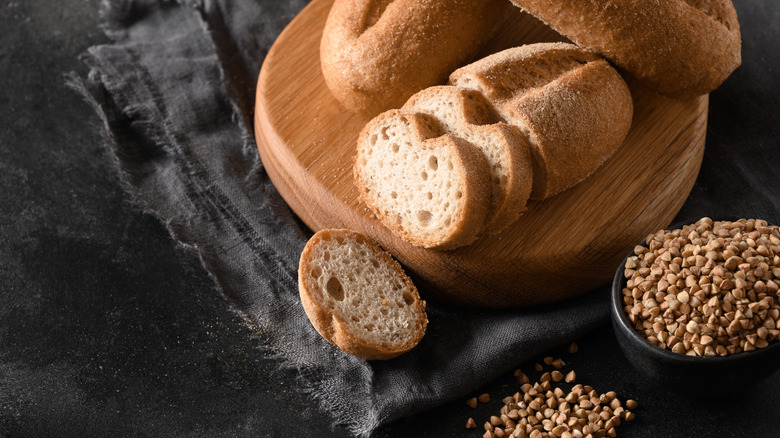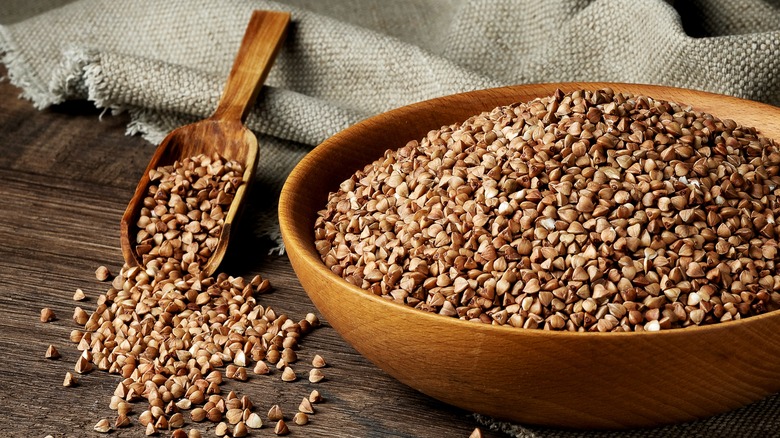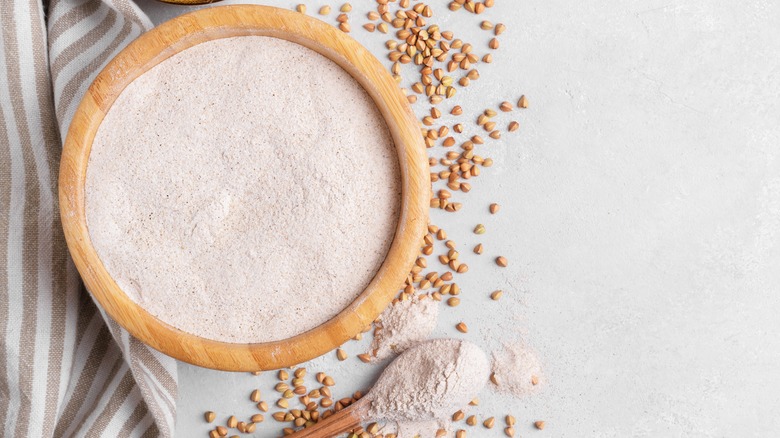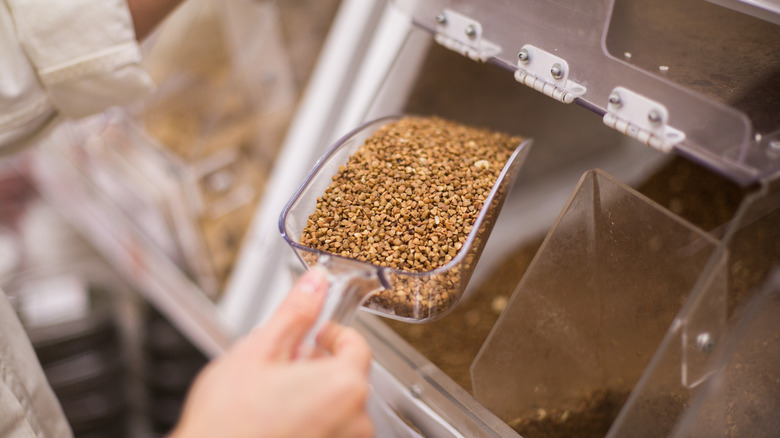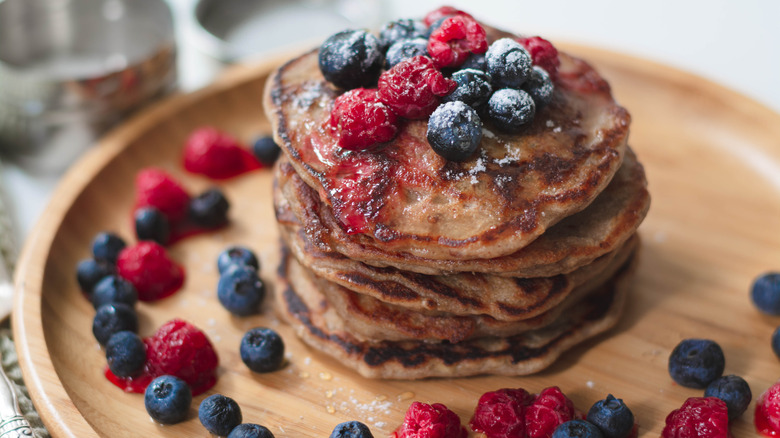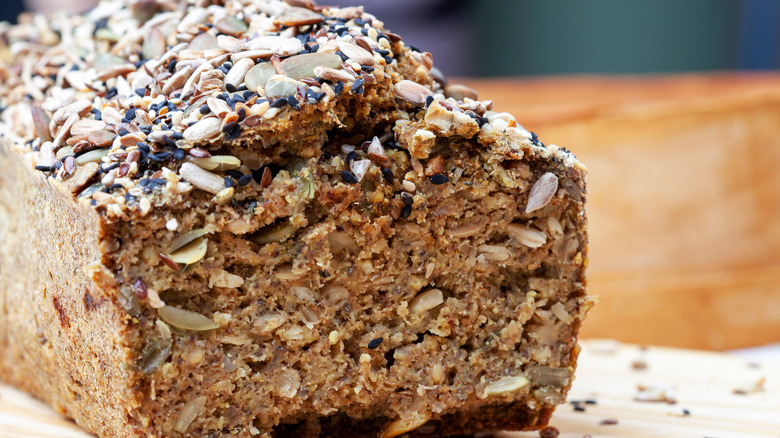The Nutty-Tasting Flour Ideal For Gluten-Free Recipes
We probably all know at least one person who abides by a gluten-free diet. And while the main reason for avoiding gluten stems from celiac disease, or digestive issues caused by consuming the gluten found in grains, per Cleveland Clinic, there are other reasons you may want to skip it. As noted by Clean Eating Kitchen, gluten can be an inflammatory substance that makes certain conditions like arthritis worse and can also cause thyroid problems. Whether you want to avoid gluten for health issues or other reasons, if you've used gluten-free flour substitutes, you may have noticed that there can be a learning curve when it comes to finding a flour with the right flavor.
According to a test of three gluten-free flours by Food Network, many of the best performing gluten-free flours contain ingredients such as rice, sorghum, tapioca, millet, and potato starch. And while these ingredients may yield great results when baking up breads, cookies, or pancakes, they may lack certain elements of flavor, texture, or even color, that mimic recipes made using traditional flours.
If you're looking for a gluten-free flour ingredient that can add depth, a richer texture, as well as a nutty, slightly earthy flavor to your baked items, there's a gluten-free flour you should try.
What is buckwheat?
That flour is buckwheat, and if you've never eaten it or tried cooking with it, you may want to consider adding it to your pantry. According to King Arthur Baking Company, despite having the word "wheat" in the name, buckwheat is actually a gluten-free product. And Bob's Red Mill describes buckwheat as a pseudocereal, meaning that it is a plant, not a grain. Per The Spruce Eats, a pseudocereal is "a plant that produces seed or fruit that is used or consumed as grains," and aren't part of a grass plant family.
Although it's most commonly consumed as a flour, buckwheat comes in a few different forms. As noted by Washington Post, you can find buckwheat groats (hulled seed from the plant), kasha, which is a form of roasted groats, and ground seeds sold as buckwheat flour.
Using the flour can add depth to your recipes and King Arthur Baking Company reports that buckwheat has an earthy, sweet flavor that pairs well with nuts, baked fruit, chocolate, and caramel.
How is buckwheat flour made?
Even though it's not a form of wheat, buckwheat flour, like wheat flour, can be purchased in two types, light and dark. As Go Healthy With Bea reports, light buckwheat flour is made from the hulled form of the plant and dark buckwheat flour is made from the unhulled seed. Cooks Info explains that unhulled buckwheat means there's a triangular-shaped covering, or hull, over the seed. Since buckwheat hull can be tough and it contains a hard shell, dark buckwheat flour has a richer texture, deeper color, and a more intense nutty, and sometimes, slightly bitter taste than the light buckwheat flour made from the unhulled seed.
No matter if you prefer the light or dark type of flour, because both unhulled and hulled buckwheat can be ground, buckwheat flour is not only tasty and useful, it's also easy to make. According to From the Larder, buckwheat flour is made by milling roasted groats until they reach the consistency of flour.
Where to purchase buckwheat
Vegan Atlas reports that buckwheat groats are often sold in various grinds, or sizes, that range from fine, medium, and course, and notes that groats can be found in the bulk foods sections of health or natural food grocery stores. That said, they are also something you can make at home, as long as you start with buckwheat groats and you have the right equipment to mill it. In fact, making buckwheat flour at home can save money, since the whole groats are usually less expensive than pre-made flour, as detailed by Dish by Dish.
Buona Pappa also shared that buckwheat flour can be found in most grocery stores but agreed with Dish by Dish that making it at home is "insanely easy and cheaper" than purchasing the product at your local market.
Stores like Walmart and Whole Foods carry various buckwheat products, including flour and seeds, as does Amazon.
Cooking with buckwheat flour
As noted by Bon Appétit, buckwheat flour can be used in a number of ways, including making noodles and in baking. However, you may need to adjust the amount of liquids used in the recipe as buckwheat flour can absorb moisture at a higher rate than other flours. And as is the case with other gluten-free flours, you're not able to just swap it out for regular all-purpose flour one-for-one due to buckwheat flour's density.
Food52 reports that using buckwheat flour for the entire recipe may give you a crumbly texture that's not pleasant to eat and notes that when baking with buckwheat flour, it is best to replace only around 25% of the traditional wheat flour with buckwheat flour in baking recipes such as breads, scones, cookies, biscuits, crackers, cakes, and muffins. However, if you like the results, you are encouraged to add a bit more the next time.
Buckwheat's nutritional benefits
As detailed by Live Strong, buckwheat flour has a low glycemic index, despite containing a high amount of total carbohydrates. Foods that are lower on the glycemic index help your body maintain a steady blood-sugar level, decrease cholesterol, reduce risk of certain cancers, and reduce inflation. Having stable blood-sugar levels impacts everything from your mood to sugar cravings and even your ability to focus, per nutritionist Stephanie Kay.
In addition to being a healthy carbohydrate, buckwheat contains fiber and protein, as noted by HealthLine. The health benefits of adding more fiber into your meals include maintaining a healthy weight and reducing your risk of cardiovascular disease, according to Mayo Clinic. Most of us know that fiber is something we should try to work into our diets and using bit of buckwheat in your next baked item or batch of pancakes are a couple of easy ways to do so — with the added benefit of incorporating the unique, bitter flavor of buckwheat.
